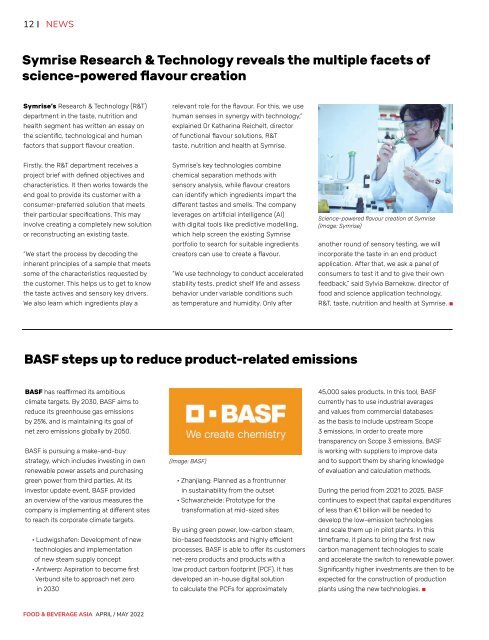Food & Beverage Asia April/May 2022
Food & Beverage Asia (FBA) is the leading source of food and beverage news in Asia since 2002. FBA delivers a comprehensive view of the food and beverage landscape, spanning across the latest health and nutrition trends and industry innovations in ingredients, recipe formulations, food science, sustainability, packaging, and automation, as well as advancements in agri and food-tech.
Food & Beverage Asia (FBA) is the leading source of food and beverage news in Asia since 2002. FBA delivers a comprehensive view of the food and beverage landscape, spanning across the latest health and nutrition trends and industry innovations in ingredients, recipe formulations, food science, sustainability, packaging, and automation, as well as advancements in agri and food-tech.
You also want an ePaper? Increase the reach of your titles
YUMPU automatically turns print PDFs into web optimized ePapers that Google loves.
12<br />
NEWS<br />
Symrise Research & Technology reveals the multiple facets of<br />
science-powered flavour creation<br />
Symrise’s Research & Technology (R&T)<br />
department in the taste, nutrition and<br />
health segment has written an essay on<br />
the scientific, technological and human<br />
factors that support flavour creation.<br />
relevant role for the flavour. For this, we use<br />
human senses in synergy with technology,”<br />
explained Dr Katharina Reichelt, director<br />
of functional flavour solutions, R&T<br />
taste, nutrition and health at Symrise.<br />
Firstly, the R&T department receives a<br />
project brief with defined objectives and<br />
characteristics. It then works towards the<br />
end goal to provide its customer with a<br />
consumer-preferred solution that meets<br />
their particular specifications. This may<br />
involve creating a completely new solution<br />
or reconstructing an existing taste.<br />
“We start the process by decoding the<br />
inherent principles of a sample that meets<br />
some of the characteristics requested by<br />
the customer. This helps us to get to know<br />
the taste actives and sensory key drivers.<br />
We also learn which ingredients play a<br />
Symrise's key technologies combine<br />
chemical separation methods with<br />
sensory analysis, while flavour creators<br />
can identify which ingredients impart the<br />
different tastes and smells. The company<br />
leverages on artificial intelligence (AI)<br />
with digital tools like predictive modelling,<br />
which help screen the existing Symrise<br />
portfolio to search for suitable ingredients<br />
creators can use to create a flavour.<br />
“We use technology to conduct accelerated<br />
stability tests, predict shelf life and assess<br />
behavior under variable conditions such<br />
as temperature and humidity. Only after<br />
Science-powered flavour creation at Symrise<br />
(Image: Symrise)<br />
another round of sensory testing, we will<br />
incorporate the taste in an end product<br />
application. After that, we ask a panel of<br />
consumers to test it and to give their own<br />
feedback,” said Sylvia Barnekow, director of<br />
food and science application technology,<br />
R&T, taste, nutrition and health at Symrise. ■<br />
BASF steps up to reduce product-related emissions<br />
BASF has reaffirmed its ambitious<br />
climate targets. By 2030, BASF aims to<br />
reduce its greenhouse gas emissions<br />
by 25%, and is maintaining its goal of<br />
net zero emissions globally by 2050.<br />
BASF is pursuing a make-and-buy<br />
strategy, which includes investing in own<br />
renewable power assets and purchasing<br />
green power from third parties. At its<br />
investor update event, BASF provided<br />
an overview of the various measures the<br />
company is implementing at different sites<br />
to reach its corporate climate targets.<br />
• Ludwigshafen: Development of new<br />
technologies and implementation<br />
of new steam supply concept<br />
• Antwerp: Aspiration to become first<br />
Verbund site to approach net zero<br />
in 2030<br />
(Image: BASF)<br />
• Zhanjiang: Planned as a frontrunner<br />
in sustainability from the outset<br />
• Schwarzheide: Prototype for the<br />
transformation at mid-sized sites<br />
By using green power, low-carbon steam,<br />
bio-based feedstocks and highly efficient<br />
processes, BASF is able to offer its customers<br />
net-zero products and products with a<br />
low product carbon footprint (PCF). It has<br />
developed an in-house digital solution<br />
to calculate the PCFs for approximately<br />
45,000 sales products. In this tool, BASF<br />
currently has to use industrial averages<br />
and values from commercial databases<br />
as the basis to include upstream Scope<br />
3 emissions. In order to create more<br />
transparency on Scope 3 emissions, BASF<br />
is working with suppliers to improve data<br />
and to support them by sharing knowledge<br />
of evaluation and calculation methods.<br />
During the period from 2021 to 2025, BASF<br />
continues to expect that capital expenditures<br />
of less than €1 billion will be needed to<br />
develop the low-emission technologies<br />
and scale them up in pilot plants. In this<br />
timeframe, it plans to bring the first new<br />
carbon management technologies to scale<br />
and accelerate the switch to renewable power.<br />
Significantly higher investments are then to be<br />
expected for the construction of production<br />
plants using the new technologies. ■<br />
FOOD & BEVERAGE ASIA APRIL / MAY <strong>2022</strong>


















